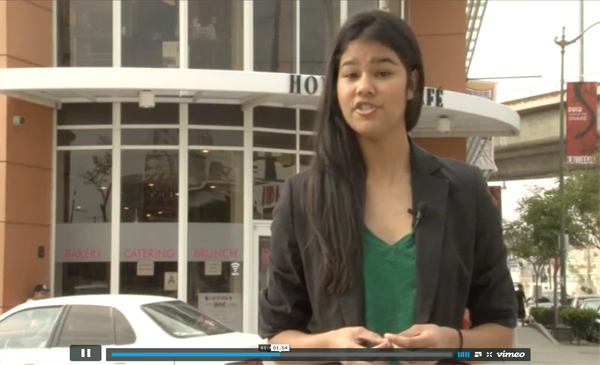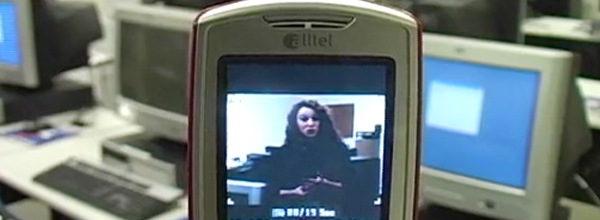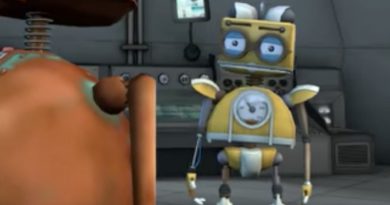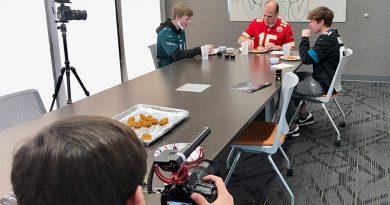Reporter Stand-ups for Broadcast News Stories
One of the assignments I use during the first semester of Broadcast Journalism I, our introductory class for sophomores, goes something like this.
- Hand out a short simple script for a news story that could happen at our school (I make up the script)
- Leave a “hole” in the story, the place where a reporter stand-up could/should go
- After students read the entire script, and understand the story, they are sent to the halls in pairs, where each kid records a stand-up to fill the hole.
- Review and discuss the stand-ups in class
This “stand-up” assignment is designed to make the students think about context, write to the moment, and find an appropriate location for the stand-up. Bonus points for doing something creative in the stand-up to make it more interesting. Their advantage is, they have the script and know exactly where the stand-up is going.

Most of the time, my kids shoot stand-ups in the field, which I require, and then when they actually edit the story, that stand-up does not necessarily work. I would say about half of the stand-ups they shoot actually make the final cut. But that is okay. It is still worthwhile to make them shoot the stand-ups. It actually makes them think about the way they will edit the story later on, and that is advanced. That is the beginning of thinking like an editor or producer in the field.
There are quite a few ways to use stand-ups, and there are quite a few types of stand-ups. First, the “why” question: Why do a stand-up in the first place?
- The worst reason is for face time. Some kids think they have to have that. But the story is not about them. So they may need some coaching about this.
- Stand-ups should be used to move stories along, to transition to “something else” they need to share.
- They can also be used when the reporter has to become the b-roll because there are no pictures available for that part of the story.
I am not a fan of stories beginning or ending with a reporter stand-up. Why? Because I think stories should start with interesting images and sound, something to grab the viewer. I also believe stories should not end with a reporter stand-up, but instead, leave the viewer with a strong image, or a strong sound bite, anything that will leave a lasting impression and tie a bow on the piece. That is usually not the teen reporter just standing on camera talking. It is important to remember that all “rules” regarding stand-ups can be broken. There are always exceptions, and creative options.
Types of stand-ups I like include:
- Take me to the scene Viewers like to see where a news event is happening, or even where it happened in the past. This is why you see local reporters in front of buildings that may be closed by the time the newscast airs…but “this is where the school board met earlier this evening” seems to engage viewers more.
- Use a prop If you have a prop you can hold up while you talk, because it is important to the story, go for it. It gives viewers something to look at while you describe the prop, or talk about why it is important.
- Creative Interaction This is one that needs some choreography at times so you get it right, but basically, you interact with the place you are covering, or the people you are covering. This one works well in light features. For example, wrapping up a story about the local stable by riding a horse on camera, or driving up in a go-kart as you do a stand-up about the new amusement park.
- Transitions Maybe the one I teach the most, the transitional stand-up moves the story in a new direction. The reporter takes the viewer by the hand and introduces a new angle, or even brings up an angle the viewer did not see coming. NOTE: Transitional stand-ups can incorporate the other stand-up techniques
- Demonstration Reporters can show viewers how something works, or how something happened in the story. These can be engaging, but they often have to be rehearsed more than other stand-ups, depending on how complicated they are. I once saw raw footage of a professional reporter burning through two tapes trying to get a demonstration stand-up just right. Pity the photog!
See examples of these types of stand-ups in this video clip:
The biggest problem with student stand-ups is that they are not written well, and do not actually follow logically what just happened, and what happens next in the story. Remember, stand-ups should be followed by a sound bite, or compelling natural sound, but not by a voiceover. Why use a reporter on camera, only to lead into a reporter’s voice track?
Effective stand-ups are about effective team work. The photographer should have as much input as the reporter as they consider the type of stand-up, and the right location. Remember, the location of the stand-up should have something to do with the subject they are covering. There is no reason to do a stand-up in the school library, for instance, when the piece is about the aging parking lot, or the school wrestling team.
There are many more types of stand-ups and ways to incorporate them in a story. The best advice I can give is to constantly remind students that a stand-up should move the story along, and not just provide 15 seconds of face time. They should flow naturally with the rest of the piece.
Finally, if you have to conclude a story with a stand-up, do it creatively if possible. And if you have to start a story with a stand-up, make sure it is written well and makes the viewer want to hang around for the pictures and sound you are about to bring them.
Dave Davis advises HTV Magazine at Hillcrest High School in Springfield, MO. HTV is the recipient of 12 NSPA Pacemaker Awards and multiple Robert F. Kennedy Awards. Find him on Twitter at @davishtv.





Pingback:Thursday Tips-Dec 11, 2014 | Missouri InterScholastic Press Association